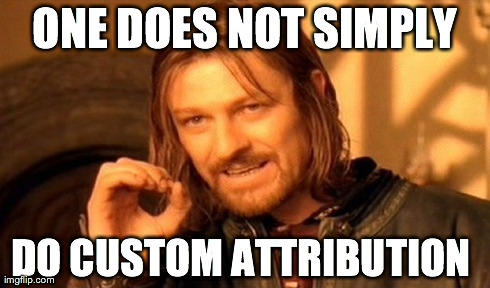
On the way to a conversion or purchase, customers typically interact with multiple touchpoints that are pieces of the marketing puzzle. Customers may encounter a display ad, receive a mobile push notification for a sale at a local store, or research products on your website. All of these interactions play a different role in the customer’s decision-making process.
The seeds of the purchasing decision may be planted long before a decision to purchase, such as during an initial search. To plan future marketing campaigns, your business needs an accurate understanding of attribution, or the influence interactions with particular touchpoints have over the purchasing decision.
But how does your company figure out which interactions influence the buying decision the most strongly? According to eTail’s Mid-Year E-Commerce Outlook, 47% of the retail organizations surveyed see a lack of full attribution visibility as their biggest pain point in designing effective marketing plans.
Every customer interaction is a piece of the conversion puzzle. But where does each one fit in the customer’s path to purchase?
Rethinking Attribution Models
The traditional way to approach attribution was to give the “last click” the most credit for conversion. This model is easy to follow because the click that seals the deal is clearly responsible for the final decision to buy.
Right?
Unfortunately, no. The “last click” attribution model only accounts for the bottom of the sales funnel. A study conducted by eConsultancy and Google found that even though less than 1 in 10 marketers consider the last click attribution method to be effective, over half of them persist in using it. As customers expand their buyers’ journeys to include more and more touchpoints, the “last click” model of attribution continues to lose relevance.
The rise of mobile and social has led to more complicated paths to purchase as customers research products and services, consult reviews, and discuss their decision-making process with members of their social network. To understand the entire decision-making process, marketers need to analyze the influence that awareness channels have on customers.
Beyond the Last Click Attribution Model
To gain a full-funnel understanding of attribution, interactions with each touchpoint in the customer journey need to be analyzed. Clues to the relevance of each touchpoint could, for instance, reside in the duration of the interaction or the length of time between the interaction and the conversion.
Alternative attribution models try to uncover the true value of each interaction in the customer journey rather than relying on the first or last click. For instance, the time decay model assumes that the closer an interaction occurs to conversion, the greater its value. A position-based model gives the greatest value to the first and last clicks, while attributing the same value to each step along the way instead of ignoring the middle steps.
While these models are an important improvement over the last-click model, they are still only guesses at the value of each interaction. Attribution analytics are the key to achieving a complex and accurate view of the significance of customer touchpoints. Attribution analytics are part of the increasingly influential field of marketing analytics. Forbes reports that 90% of marketing organizations experience considerable benefits from marketing analytics.
To benefit from the insights gained from attribution analytics, your company needs an analytics platform that enables not only predictive analytics, but also prescriptive analytics that suggest possible courses of action and their benefits or risks. While predictive analytics can use past consumer behavior to predict future customer journeys, prescriptive analytics can propose options for customizing your media mix. Then, you can test options to reach the best solution for personalized customer engagement.
Reaching the Right Media Mix
Once your business gains the correct understanding of which touchpoints are driving purchases, you can allocate dollars from a sale to the touchpoints the customer was exposed to before conversion. The dollar value can be assigned proportionally according to the touchpoint’s influence on the customer’s purchasing decision.
These attributions can then be used to formulate the media mix used for each customer segment in future marketing campaigns. More emphasis can be placed on channels that had a larger influence over the purchasing decision so you can optimize your marketing spend and increase rates of conversion.
Because the journey is different for every customer, attribution will vary for each customer segment. Gathering information about each segment allows you to customize your marketing spend and media mix for specific groups of customers.
Does your business need help solving the marketing attribution puzzle? Enough about you, let’s talk about us. Find out how Pluris can improve your current marketing plan.


